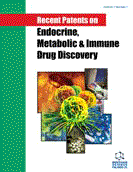Abstract
Tyrosine kinase receptors play an important role in tumor angiogenesis and, their implication in epithelial thyroid tumor growth has been highlighted. Sunitinib is a novel tyrosine kinase inhibitor, approved in 2006 by Food and Drug Administration for the treatment of advanced renal cell and gastrointestinal stromal tumors. Preliminary promising results have been also obtained in patients with RAI-resistant thyroid neoplasia. In the current study, our experience on 9 patients with advanced thyroid epithelial cancer is analyzed and discussed in relation to the new patents in this field. According to RECIST criteria, partial response was obtained in 5/9 (55.5%) patients at 3 months and in 6/9 (66.6%) at 6 months. Median treatment follow-up was 13.0 months and median overall survival and progression-free survival were 20 [95% confidence interval (CI) 9.3 - 30.6] and 21 months (95% CI 6.9 - 35.1), respectively. One case of severe thoracic hemorrhage was observed, the most common adverse events being represented by fatigue, (44.4%), skin rash (33.3%), headache (33.3%), and one case each of hypertension, macrocytosis and acute pneumonia. These results confirm sunitinib as a potential useful tool for the treatment of advanced thyroid cancers and may open the way for new patents of molecules with more specific target selectivity.
Keywords: Metastasis, sunitinib, thyroid cancer, tyrosin-kinase inhibitor, multi-kinase inhibitors, RAI-resistant thyroid cancer, iodine refractory, pulmonary hemorrhage, ERK pathway, anti-angiogenic activity
 21
21





















